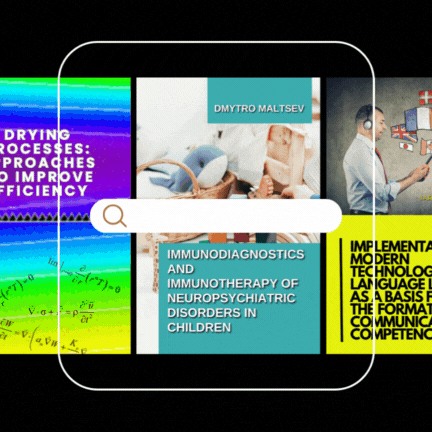Вдосконалення моделі нейронної мережі для семантичної сегментації зображень об’єктів моніторингу на аерофотознімках
DOI:
https://doi.org/10.15587/1729-4061.2021.248390Ключові слова:
семантична сегментація зображень, згорткова нейронна мережа, аерофотознімок, безпілотний літальний апаратАнотація
Розглянуто модель нейронної мережі для семантичної сегментації зображень об'єктів моніторингу на аерофотознімках. Безпілотні літальні апарати здійснюють моніторинг об'єктів шляхом аналізу (обробки) аерофотознімків та відеопотоку. Результати аерофотозйомки обробляються оператором у ручному режимі, але є об'єктивні труднощі, пов'язані з обробкою оператором великої кількості аерофотознімків, тому доцільно цей процес автоматизувати. Аналіз моделей показав, що для виконання завдання семантичної сегментації зображень об'єктів моніторингу на аерофотознімках в якості базової моделі найбільш підходить модель U-Net (Німеччина), яка є нейронною мережею. Дану модель вдосконалено шляхом використання вейвлет шару та застосуванням оптимальних значень параметрів навчання моделі: швидкість (крок) – 0,001, число епох – 60, алгоритм оптимізації – Adam. Навчання проводилось набором сегментованих зображень, які підготовлені з аерофотознімків (роздільною здатністю 6000×4000 пікселів) програмою Image Labeler середовища математичного моделювання MATLAB R2020b (США). В результаті отримано нову модель семантичної сегментації зображень об'єктів моніторингу на аерофотознімках із запропонованою назвою U-NetWavelet.
Проведено дослідження ефективності вдосконаленої моделі на прикладі обробки 80 аерофотознімків. В якості показників ефективності моделі обрані: точність; чутливість; помилка сегментації. Використання модифікованого вейвлету шару дозволило адаптувати розмір аерофотознімка до параметрів вхідного шару нейронної мережі, підвищити оперативність сегментації зображень на аерофотознімках, а застосування згорткової нейронної мережі дозволило автоматизувати даний процес
Посилання
- Pospelov, B., Andronov, V., Rybka, E., Krainiukov, O., Maksymenko, N., Meleshchenko, R. et. al. (2020). Mathematical model of determining a risk to the human health along with the detection of hazardous states of urban atmosphere pollution based on measuring the current concentrations of pollutants. Eastern-European Journal of Enterprise Technologies, 4 (10 (106)), 37–44. doi: https://doi.org/10.15587/1729-4061.2020.210059
- Semko, A. N., Beskrovnaya, M. V., Vinogradov, S. A., Hritsina, I. N., Yagudina, N. I. (2014). The usage of high speed impulse liquid jets for putting out gas blowouts. Journal of Theoretical and Applied Mechanics, 52 (3), 655–664.
- Chernukha, A., Teslenko, A., Kovalov, P., Bezuglov, O. (2020). Mathematical Modeling of Fire-Proof Efficiency of Coatings Based on Silicate Composition. Materials Science Forum, 1006, 70–75. doi: https://doi.org/10.4028/www.scientific.net/msf.1006.70
- Vambol, S., Vambol, V., Kondratenko, O., Suchikova, Y., Hurenko, O. (2017). Assessment of improvement of ecological safety of power plants by arranging the system of pollutant neutralization. Eastern-European Journal of Enterprise Technologies, 3 (10 (87)), 63–73. doi: https://doi.org/10.15587/1729-4061.2017.102314
- Vambol, S., Vambol, V., Sobyna, V., Koloskov, V., Poberezhna, L. (2018). Investigation of the energy efficiency of waste utilization technology, with considering the use of low-temperature separation of the resulting gas mixtures. Energetika, 64 (4), 186–195. doi: https://doi.org/10.6001/energetika.v64i4.3893
- Pospelov, B., Rybka, E., Meleshchenko, R., Borodych, P., Gornostal, S. (2019). Development of the method for rapid detection of hazardous atmospheric pollution of cities with the help of recurrence measures. Eastern-European Journal of Enterprise Technologies, 1 (10 (97)), 29–35. doi: https://doi.org/10.15587/1729-4061.2019.155027
- Dadashov, I., Loboichenko, V., Kireev, A. (2018). Analysis of the ecological characteristics of environment friendly fire fighting chemicals used in extinguishing oil products. Pollution Research, 37 (1), 63–77. Available at: http://repositsc.nuczu.edu.ua/handle/123456789/6849
- Holla, A., Pai, M., Verma, U., Pai, R. M. (2020). Efficient Vehicle Counting by Eliminating Identical Vehicles in UAV aerial videos. 2020 IEEE International Conference on Distributed Computing, VLSI, Electrical Circuits and Robotics (DISCOVER), 246–251. doi: https://doi.org/10.1109/discover50404.2020.9278095
- Deng, H., Zhang, Y., Li, R., Hu, C., Feng, Z., Li, H. (2022). Combining residual attention mechanisms and generative adversarial networks for hippocampus segmentation. Tsinghua Science and Technology, 27 (1), 68–78. doi: https://doi.org/10.26599/tst.2020.9010056
- Jing, W., Jin, T., Xiang, D. (2021). Fast Superpixel-Based Clustering Algorithm for SAR Image Segmentation. IEEE Geoscience and Remote Sensing Letters, 1–1. doi: https://doi.org/10.1109/lgrs.2021.3124071
- Xin, L., Chao, L., He, L. (2021). Malicious code detection method based on image segmentation and deep residual network RESNET. 2021 International Conference on Computer Engineering and Application (ICCEA), 473–480. doi: https://doi.org/10.1109/ICCEA53728.2021.00099
- Xie, B., Yang, Z., Yang, L., Luo, R., Wei, A., Weng, X., Li, B. (2021). Multi-Scale Fusion With Matching Attention Model: A Novel Decoding Network Cooperated With NAS for Real-Time Semantic Segmentation. IEEE Transactions on Intelligent Transportation Systems, 1–11. doi: https://doi.org/10.1109/tits.2021.3115705
- Yang, S., Hou, J., Jia, Y., Mei, S., Du, Q. (2021). Superpixel-Guided Discriminative Low-Rank Representation of Hyperspectral Images for Classification. IEEE Transactions on Image Processing, 30, 8823–8835. doi: https://doi.org/10.1109/tip.2021.3120675
- Peng, C., Zhang, K., Ma, Y., Ma, J. (2021). Cross Fusion Net: A Fast Semantic Segmentation Network for Small-Scale Semantic Information Capturing in Aerial Scenes. IEEE Transactions on Geoscience and Remote Sensing, 60, 1–13. doi: https://doi.org/10.1109/tgrs.2021.3053062
- Ronneberger, O., Fischer, P., Brox, T. (2015). U-Net: Convolutional Networks for Biomedical Image Segmentation. Medical Image Computing and Computer-Assisted Intervention – MICCAI 2015, 234–241. doi: https://doi.org/10.1007/978-3-319-24574-4_28
- Jwaid, W. M., Al-Husseini, Z. S. M., Sabry, A. H. (2021). Development of brain tumor segmentation of magnetic resonance imaging (MRI) using U-Net deep learning. Eastern-European Journal of Enterprise Technologies, 4 (9 (112)), 23–31. doi: https://doi.org/10.15587/1729-4061.2021.238957
- Slyusar, V., Protsenko, M., Chernukha, A., Gornostal, S., Rudakov, S., Shevchenko, S. et. al. (2021). Construction of an advanced method for recognizing monitored objects by a convolutional neural network using a discrete wavelet transform. Eastern-European Journal of Enterprise Technologies, 4 (9 (112)), 65–77. doi: https://doi.org/10.15587/1729-4061.2021.238601
- Slyusar, V., Protsenko, M., Chernukha, A., Kovalov, P., Borodych, P., Shevchenko, S. et. al. (2021). Improvement of the model of object recognition in aero photographs using deep convolutional neural networks. Eastern-European Journal of Enterprise Technologies, 5 (2 (113)), 6–21. doi: https://doi.org/10.15587/1729-4061.2021.243094
- Long, J., Shelhamer, E., Darrell, T. (2015). Fully convolutional networks for semantic segmentation. 2015 IEEE Conference on Computer Vision and Pattern Recognition (CVPR). doi: https://doi.org/10.1109/cvpr.2015.7298965
- Badrinarayanan, V., Kendall, A., Cipolla, R. (2017). SegNet: A Deep Convolutional Encoder-Decoder Architecture for Image Segmentation. IEEE Transactions on Pattern Analysis and Machine Intelligence, 39 (12), 2481–2495. doi: https://doi.org/10.1109/tpami.2016.2644615
- Zhao, H., Shi, J., Qi, X., Wang, X., Jia, J. (2017). Pyramid Scene Parsing Network. 2017 IEEE Conference on Computer Vision and Pattern Recognition (CVPR). doi: https://doi.org/10.1109/cvpr.2017.660
##submission.downloads##
Опубліковано
Як цитувати
Номер
Розділ
Ліцензія
Авторське право (c) 2021 Vadym Slyusar, Mykhailo Protsenko, Anton Chernukha, Vasyl Melkin, Olena Petrova, Mikhail Kravtsov, Svitlana Velma, Nataliia Kosenko, Olga Sydorenko, Maksym Sobol

Ця робота ліцензується відповідно до Creative Commons Attribution 4.0 International License.
Закріплення та умови передачі авторських прав (ідентифікація авторства) здійснюється у Ліцензійному договорі. Зокрема, автори залишають за собою право на авторство свого рукопису та передають журналу право першої публікації цієї роботи на умовах ліцензії Creative Commons CC BY. При цьому вони мають право укладати самостійно додаткові угоди, що стосуються неексклюзивного поширення роботи у тому вигляді, в якому вона була опублікована цим журналом, але за умови збереження посилання на першу публікацію статті в цьому журналі.
Ліцензійний договір – це документ, в якому автор гарантує, що володіє усіма авторськими правами на твір (рукопис, статтю, тощо).
Автори, підписуючи Ліцензійний договір з ПП «ТЕХНОЛОГІЧНИЙ ЦЕНТР», мають усі права на подальше використання свого твору за умови посилання на наше видання, в якому твір опублікований. Відповідно до умов Ліцензійного договору, Видавець ПП «ТЕХНОЛОГІЧНИЙ ЦЕНТР» не забирає ваші авторські права та отримує від авторів дозвіл на використання та розповсюдження публікації через світові наукові ресурси (власні електронні ресурси, наукометричні бази даних, репозитарії, бібліотеки тощо).
За відсутності підписаного Ліцензійного договору або за відсутністю вказаних в цьому договорі ідентифікаторів, що дають змогу ідентифікувати особу автора, редакція не має права працювати з рукописом.
Важливо пам’ятати, що існує і інший тип угоди між авторами та видавцями – коли авторські права передаються від авторів до видавця. В такому разі автори втрачають права власності на свій твір та не можуть його використовувати в будь-який спосіб.










